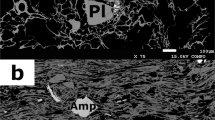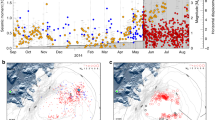Abstract
The largest volcanic eruptions in the geologic record have no analogue in the historical record. These eruptions had global impacts1,2, but are known only through their eruptive products. They have left behind calderas that formed as the surface collapsed when eruption evacuated magma chambers at 5–15 km depths3,4. It is generally assumed that calderas reflect the spatial dimensions of underlying magma reservoirs. Here we use a numerical model of conduit flow and dynamic magma-chamber drainage to show that caldera size can be affected by the material properties of crystal-rich silicic magma. We find that magma in the chamber can experience a rheological transition during eruption. This transition causes magma near the conduit to behave as a fluid, whereas magma farther away behaves elastically and remains locked. The intervening surface—the yield surface—expands through the chamber as eruption progresses. If a yielding transition occurs, calderas can form before complete mobilization of the entire reservoir. The resulting distribution of eruption volumes is then bimodal, as observed in the geologic record. We suggest that the presence or absence of a magma yield stress determines whether caldera size reflects the true spatial extent of magma storage.
This is a preview of subscription content, access via your institution
Access options
Subscribe to this journal
Receive 12 print issues and online access
$259.00 per year
only $21.58 per issue
Buy this article
- Purchase on Springer Link
- Instant access to full article PDF
Prices may be subject to local taxes which are calculated during checkout



Similar content being viewed by others
References
Self, S. The effects and consequences of very large explosive volcanic eruptions. Phil. Trans. R. Soc. A 364, 2073–2097 (2006).
Bryan, S. E. et al. The largest volcanic eruptions on Earth. Earth Sci. Rev. 102, 207–229 (2010.).
Lindsay, J. M. et al. Magmatic evolution of the La Pacana caldera system, central Andes, Chile: Compositional variation of two cogenetic large-volume felsic ignimbrites. J. Petrol. 42, 459–486 (2001).
Lipman, P. Incremental assembly and prolonged consolidation of Cordilleran magma chambers: Evidence from the southern Rocky Mountain volcanic field. Geosphere 3, 42–70 (2007).
Bachmann, O. On the origin of crystal-poor rhyolites: Extracted from batholithic crystal mushes. J. Petrol. 45, 1565–1582 (2004).
Turner, S. & Costa, F. Measuring timescales of magmatic evolution. Elements 3, 267–272 (2007).
Druitt, T., Costa, F., Deloule, E., Dungan, M. & Scaillet, B. Decadal to monthly timescales of magma transfer and reservoir growth at a caldera volcano. Nature 482, 77–80 (2012).
Halliday, A. N. et al. Evidence for long residence times of rhyolitic magma in the Long Valley magmatic system: The isotopic record in precaldera lavas of Glass Mountain. Earth Planet. Sci. Lett. 94, 274–290 (1989).
Pallister, J. S., Hoblitt, R. P. & Reyes, A. G. A basaltic trigger for the 1991 eruptions of Pinatubo volcano?. Nature 356, 426–428 (1992).
Burgisser, A. & Bergantz, G. W. A rapid mechanism to remobilize and homogenize highly crystalline magma bodies. Nature 471, 212–215 (2011).
Stickel, J. J. & Powell, R. L. Fluid mechanics and rheology of dense suspensions. Annu. Rev. Fluid Mech. 37, 129–149 (2005).
Philpotts, A., Shi, J. & Brustman, C. Role of plagioclase crystal chains in the differentiation of partly crystallized basaltic magma. Nature 395, 343–346 (1998).
Saar, M. O., Manga, M., Cashman, K. V. & Fremouw, S. Numerical models of the onset of yield strength in crystal-melt suspensions. Earth Planet. Sci. Lett. 187, 367–379 (2001).
Rampino, M. R. & Self, S. Volcanic winter and accelerated glaciation following the Toba super-eruption. Nature 359, 50–52 (1992).
Jaupart, C. & Allègre, C. J. Gas content, eruption rate and instabilities of eruption regime in silicic volcanoes. Earth Planet. Sci. Lett. 102, 413–429 (1991).
Gudmundsson, A. Formation and development of normal-fault calderas and the initiation of large explosive eruptions. Bull. Volcanol. 60, 160–170 (1998).
Self, S., Goff, F., Gardner, J., Wright, J. V. & Kite, W. M. Explosive rhyolitic volcanism in the Jemez Mountains: Vent locations, caldera development and relation to regional structure. J. Geophys. Res. 91, 1779–1798 (1986).
Geyer, A. & Marti, J. The new worldwide collapse caldera database (CCDB): A tool for studying and understanding caldera processes. J. Volcanol. Geotherm. Res. 175, 334–354 (2008).
Marti, J., Geyer, A., Folch, A. & Gottsmann, J. in Studies in Volcanology: The Legacy of George Walker (eds Thordarson, T., Self, S., Larsen, G., Rowland, S. & Hoskuldsson, A.) 249–266 (Special Publication of IAVCEI, No. 2, Geological Society, 2009).
Stix, J. & Kobayashi, T. Magma dynamics and collapse mechanisms during four historic caldera-forming events. J. Geophys. Res. 113, B09205 (2008).
Kennedy, B. M., Jellinek, A. M. & Stix, J. Coupled caldera subsidence and stirring inferred from analogue models. Nature Geosci. 1, 385–389 (2008).
Tait, S., Jaupart, C. & Vergniolle, S. Pressure, gas content and eruption periodicity of a shallow, crystallizing magma chamber. Earth Planet. Sci. Lett. 92, 107–123 (1989).
Huppert, H. & Woods, A. The role of volatiles in magma chamber dynamics. Nature 420, 493–495 (2002).
Druitt, T. H. & Sparks, R. S. J. On the formation of calderas during ignimbrite eruptions. Nature 310, 679–681 (1984).
Caricchi, L. et al. Non-Newtonian rheology of crystal-bearing magmas and implications for magma ascent dynamics. Earth Planet. Sci. Lett. 264, 402–419 (2007).
Dufek, J. & Bachmann, O. Quantum magmatism: Magmatic compositional gaps generated by melt-crystal dynamics. Geology 38, 687–690 (2010).
Liu, A. J. & Nagel, S. R. Jamming is not just cool any more. Nature 396, 21–22 (1998).
Cathey, H. E. & Nash, B. P. The Cougar Point tuff: Implications for thermochemical zonation and longevity of high-temperature, large-volume silicic magmas of the Miocene Yellowstone hotspot. J. Petrol. 45, 27–58 (2004).
Anderson, D. Lithosphere, asthenosphere, and perisphere. Rev. Geophys. 33, 125–149 (1995).
Gonnermann, H. & Manga, M. The fluid mechanics inside a volcano. Annu. Rev. Fluid Mech. 39, 321–355 (2007).
Acknowledgements
M.L.R. is supported by a Graduate Research Fellowship from the National Science Foundation. M.M. acknowledges support from the National Science Foundation Frontiers in Earth System Dynamics and the National Aeronautics and Space Administration. We thank the Collapse Caldera Database members for maintaining the system.
Author information
Authors and Affiliations
Contributions
L.K. wrote the manuscript, prepared the figures and developed the conduit-flow model. M.L.R. carried out the finite element calculations. L.K. and M.L.R. implemented the coupling between conduit flow and chamber deformation. All authors contributed to the conceptual formulation of the model and revisions to the manuscript.
Corresponding author
Ethics declarations
Competing interests
The authors declare no competing financial interests.
Supplementary information
Supplementary Information
Supplementary Information (PDF 1631 kb)
Rights and permissions
About this article
Cite this article
Karlstrom, L., Rudolph, M. & Manga, M. Caldera size modulated by the yield stress within a crystal-rich magma reservoir. Nature Geosci 5, 402–405 (2012). https://doi.org/10.1038/ngeo1453
Received:
Accepted:
Published:
Issue Date:
DOI: https://doi.org/10.1038/ngeo1453
This article is cited by
-
Ultra-crystalline pyroclastic deposits and rhyolitic lavas controlled by crystal mushes: insights from the Acoculco Caldera Complex, México
Contributions to Mineralogy and Petrology (2023)
-
Melt segregation and the architecture of magmatic reservoirs: insights from the Muroto sill (Japan)
Contributions to Mineralogy and Petrology (2019)
-
A cascade of magmatic events during the assembly and eruption of a super-sized magma body
Contributions to Mineralogy and Petrology (2017)
-
Frequency and magnitude of volcanic eruptions controlled by magma injection and buoyancy
Nature Geoscience (2014)
-
Rapid remobilization of magmatic crystals kept in cold storage
Nature (2014)



